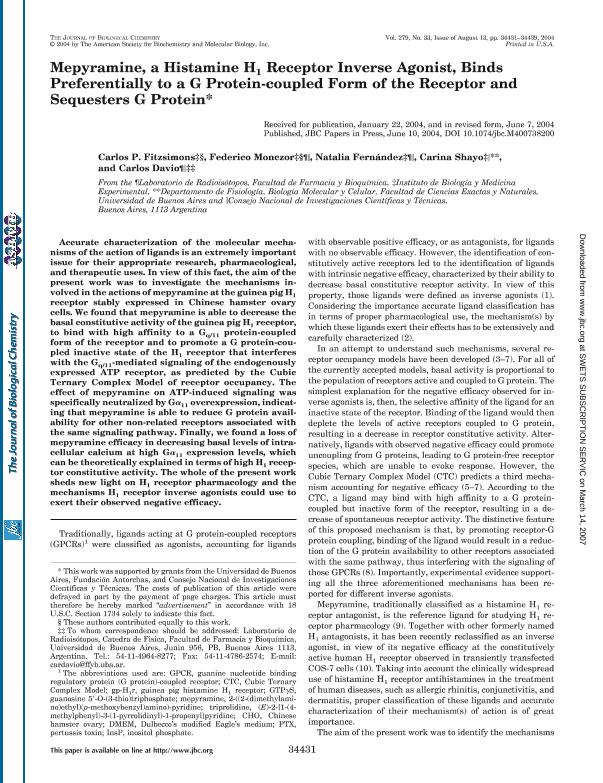Mostrar el registro sencillo del ítem
dc.contributor.author
Fitzsimons, Carlos P.
dc.contributor.author
Monczor, Federico

dc.contributor.author
Fernandez, Natalia Cristina

dc.contributor.author
Shayo, Carina Claudia

dc.contributor.author
Davio, Carlos Alberto

dc.date.available
2017-11-26T20:58:51Z
dc.date.issued
2004
dc.identifier.citation
Fitzsimons, Carlos P. ; Monczor, Federico; Fernandez, Natalia Cristina; Shayo, Carina Claudia; Davio, Carlos Alberto; Mepyramine, a histamine H1 receptor inverse agonist, binds preferentially to a G protein-coupled form of the receptor and sequesters G protein; American Society for Biochemistry and Molecular Biology; Journal of Biological Chemistry (online); 279; 33; -1-2004; 34431-34439
dc.identifier.issn
0021-9258
dc.identifier.uri
http://hdl.handle.net/11336/29135
dc.description.abstract
Accurate characterization of the molecular mechanisms of the action of ligands is an extremely important issue for their appropriate research, pharmacological, and therapeutic uses. In view of this fact, the aim of the present work was to investigate the mechanisms involved in the actions of mepyramine at the guinea pig H(1) receptor stably expressed in Chinese hamster ovary cells. We found that mepyramine is able to decrease the basal constitutive activity of the guinea pig H(1) receptor, to bind with high affinity to a G(q/11) protein-coupled form of the receptor and to promote a G protein-coupled inactive state of the H(1) receptor that interferes with the G(q/11)-mediated signaling of the endogenously expressed ATP receptor, as predicted by the Cubic Ternary Complex Model of receptor occupancy. The effect of mepyramine on ATP-induced signaling was specifically neutralized by Galpha(11) overexpression, indicating that mepyramine is able to reduce G protein availability for other non-related receptors associated with the same signaling pathway. Finally, we found a loss of mepyramine efficacy in decreasing basal levels of intracellular calcium at high Galpha(11) expression levels, which can be theoretically explained in terms of high H(1) receptor constitutive activity. The whole of the present work sheds new light on H(1) receptor pharmacology and the mechanisms H(1) receptor inverse agonists could use to exert their observed negative efficacy.
dc.format
application/pdf
dc.language.iso
eng
dc.publisher
American Society for Biochemistry and Molecular Biology

dc.rights
info:eu-repo/semantics/openAccess
dc.rights.uri
https://creativecommons.org/licenses/by-nc-sa/2.5/ar/
dc.subject
Calcium
dc.subject
Gtp Binding Proteins
dc.subject
Cell Membrane
dc.subject
Histamine H1
dc.subject.classification
Bioquímica y Biología Molecular

dc.subject.classification
Ciencias Biológicas

dc.subject.classification
CIENCIAS NATURALES Y EXACTAS

dc.title
Mepyramine, a histamine H1 receptor inverse agonist, binds preferentially to a G protein-coupled form of the receptor and sequesters G protein
dc.type
info:eu-repo/semantics/article
dc.type
info:ar-repo/semantics/artículo
dc.type
info:eu-repo/semantics/publishedVersion
dc.date.updated
2017-11-16T15:17:21Z
dc.identifier.eissn
1083-351X
dc.journal.volume
279
dc.journal.number
33
dc.journal.pagination
34431-34439
dc.journal.pais
Estados Unidos

dc.journal.ciudad
Rockville
dc.description.fil
Fil: Fitzsimons, Carlos P.. Consejo Nacional de Investigaciones Científicas y Técnicas. Instituto de Biología y Medicina Experimental. Fundación de Instituto de Biología y Medicina Experimental. Instituto de Biología y Medicina Experimental; Argentina. Universidad de Buenos Aires. Facultad de Farmacia y Bioquímica; Argentina
dc.description.fil
Fil: Monczor, Federico. Consejo Nacional de Investigaciones Científicas y Técnicas. Instituto de Biología y Medicina Experimental. Fundación de Instituto de Biología y Medicina Experimental. Instituto de Biología y Medicina Experimental; Argentina. Universidad de Buenos Aires. Facultad de Farmacia y Bioquímica; Argentina
dc.description.fil
Fil: Fernandez, Natalia Cristina. Universidad de Buenos Aires. Facultad de Farmacia y Bioquímica; Argentina. Consejo Nacional de Investigaciones Científicas y Técnicas. Instituto de Biología y Medicina Experimental. Fundación de Instituto de Biología y Medicina Experimental. Instituto de Biología y Medicina Experimental; Argentina
dc.description.fil
Fil: Shayo, Carina Claudia. Consejo Nacional de Investigaciones Científicas y Técnicas. Instituto de Biología y Medicina Experimental. Fundación de Instituto de Biología y Medicina Experimental. Instituto de Biología y Medicina Experimental; Argentina. Universidad de Buenos Aires. Facultad de Farmacia y Bioquímica; Argentina. Universidad de Buenos Aires. Facultad de Ciencias Exactas y Naturales. Departamento de Fisiología, Biología Molecular y Celular; Argentina
dc.description.fil
Fil: Davio, Carlos Alberto. Consejo Nacional de Investigaciones Científicas y Técnicas. Instituto de Biología y Medicina Experimental. Fundación de Instituto de Biología y Medicina Experimental. Instituto de Biología y Medicina Experimental; Argentina. Universidad de Buenos Aires. Facultad de Farmacia y Bioquímica; Argentina
dc.journal.title
Journal of Biological Chemistry (online)

dc.relation.alternativeid
info:eu-repo/semantics/altIdentifier/url/http://www.jbc.org/content/279/33/34431.long
dc.relation.alternativeid
info:eu-repo/semantics/altIdentifier/doi/http://dx.doi.org/10.1074/jbc.M400738200
dc.relation.alternativeid
info:eu-repo/semantics/altIdentifier/pmid/15192105
Archivos asociados
